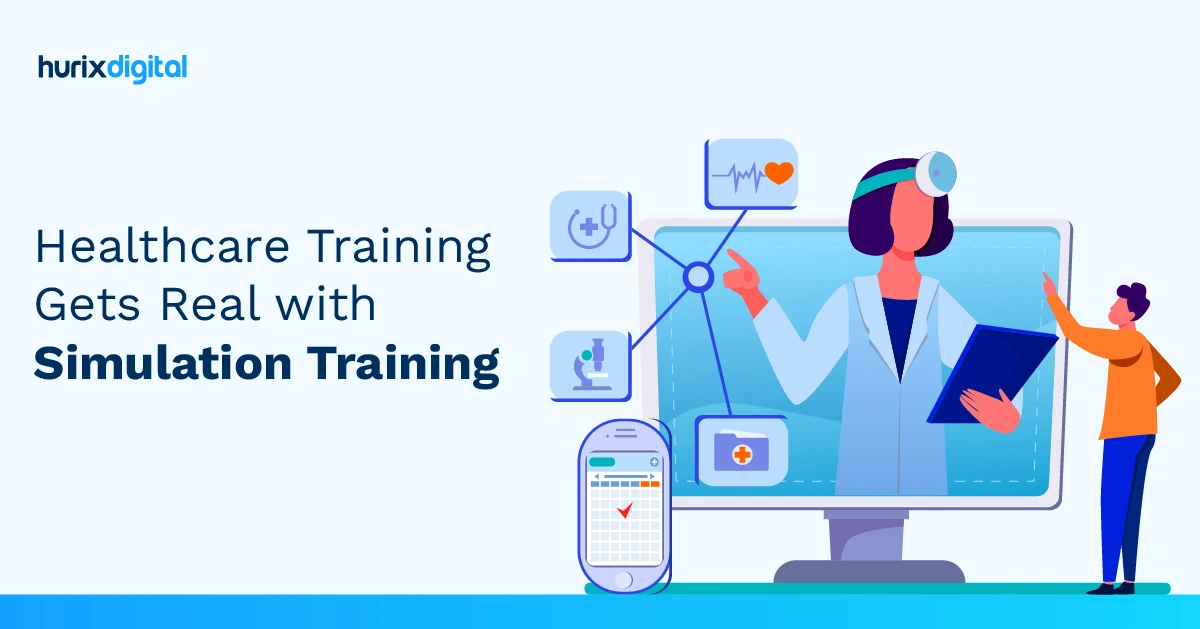
6 Reasons Why Your Organization Needs Simulation Training
Summary
Discover the power of simulation training! Our blog outlines six compelling reasons why your organization can’t afford to overlook this method. From enhanced skills acquisition to risk-free environments, simulation training offers invaluable benefits that drive performance and foster continuous learning. Don’t miss out on this transformative tool!
Simulation training is the newest technological advancement in the world of employee learning. Studies across the globe have shown that this kind of training allows for an immersive, all-encompassing experience, and hence improves the effectiveness of the training exercise.
With the rapid evolution in technology, creating a real-life mock-up scenario is no longer a complicated feat. Organizations can now benefit from the reduced risk factor during training by creating online simulations while still being able to provide real-life learning experiences.
Table of Contents:
- What is Simulation Training?
- What are the Examples of Simulation Training?
- Prominent Simulation Training Methods
- What are the Top 6 Benefits of Mobile-Based Simulation Training?
- Conclusion
- Frequently Asked Questions
What is Simulation Training?
Simulation training, as the name suggests, is a kind of training created to mirror real-life situations. Employees can put their knowledge to the test in situations they may encounter in their jobs. However, this attempt is within the safety net of simulation, thus allowing them to experiment, learn, and grow.
This training is highly cost-effective for employers. It also allows them to assess their employees concerning how they use their skills when put in pressure situations. Thus, it can help gauge each employee’s decision-making ability.
What is the Objective of Simulation Training?
What are the Examples of Simulation Training?
There are a few industries where simulation training has become the front-runner regarding training employees.
1. Aviation
The aviation industry extensively uses simulation as a training technique for its employees. Flight simulation is part of pilot training, whether commercial flying or flying an Air Force jet. Airplanes and jets are expensive. Not to mention the risk of loss of human life, which is unacceptable, this is why flight simulation is used to train pilots instead. It is not only cost-effective, but it also literally saves lives.
2. Driving
Very few things are as dangerous to people’s lives as an out-of-control driver. To prevent this from happening, driving schools across the world use simulation to train learners before they take their cars out on the road.
3. Medicine
Few professions are required to be more infallible than those in the medical field. Medical professionals cannot afford to make mistakes; lives are lost if they do. Simulation-based training is used in the training of many of these medical professionals, including surgeons.
As part of their training, surgeons often must perform surgeries on dummies or even computer-generated bodies before cutting open real ones. It allows surgeons to learn without fearing every step they take and saves hospitals and medical schools millions of dollars in damages, not to mention the countless human lives that are also saved.
4. Military Simulation Training
Military organizations use a simulation training tool that simulates different combat scenarios. This tool will give personnel experience and reaction to real-time combat with its land, air, and sea operations.
5. Simulation-Based Corporate Training
As pointed out above, simulations are now gaining importance as part of employee development by companies. For instance, business simulation programs throw participants into real-life corporate situations where participants have to handle finance, marketing, operations, and human resources management in a very competitive environment.
6. Construction and Engineering
The construction site simulation is a good area for exercising construction workers on performance and safety procedures on a simulated construction site. Using engineering design simulation, an engineer can test and improve designs before building them to reduce error and maximize efficiency.
Also Read: Adapting Workforce L&D Programs to the Virtual and Hybrid Landscapes
Prominent Simulation Training Methods
Simulation encompasses various approaches that can be customized according to specific learning objectives and the nature of the tasks. Common examples of simulation training programs examples include:
1. Live Simulations
These are real-time, dynamic scenarios that mimic real-world operations. The trainee interacts with the simulation as it is presented, solving problems and addressing live situations.
Applications include emergency response, military training, and business management.
2. Computer-Based Simulations
This training simulates real-world scenarios so that participants can interact with a computer-mediated environment. They can range from simple computer applications to very complex 3D simulations.
Applications include training programs used in healthcare, aviation, and manufacturing.
3. Virtual Reality Simulations
Organizations can develop a complete immersion environment through virtual reality technology. Learners wear VR headsets to experience scenarios as if they were there.
For example, in healthcare, where surgeons can practice procedures, and in aviation, where pilots can be seen with realistic flight training
4. Augmented Reality Simulations
With such simulation programs, digital information can be used in the real-world environment to enhance participants’ perception of their surroundings. This approach is useful for applications where real-time data must be integrated.
5. Scenario-Based Simulations
Such simulations expose learners to specific situations and challenges. Learners must navigate scenarios while making appropriate decisions and solving problems. This kind of simulation helps develop decision-making skills and even crisis management.
6. Role-Playing Simulations
Engage participants in a scenario where they can practice how to interact in a controlled environment in learning communication and interpersonal interaction, such as customer service, and negotiation.
7. Serious Games
Learning should be fun and meaningful. These simulations are developed as interactive and entertaining activities that promote learning to compete, collaborate, and resolve problems.
8. Hybrid Simulations
Organizations can utilize a combination of methods to attain integrated training. This kind of simulation program is used in training, which consists of both theoretical and practical practice.
Examples of Organizations Using Simulation Training Programs
There are quite a few popular organizations that have made simulation training a part of their employee curriculum:
1. KFC
This fast-food giant has turned its training program into a simulation game. Employees are put in an escape room scenario where they have to prepare items on the menu to escape. This allows employees to gain hands-on experience in serving fast-selling food items in record time and makes the whole experience fun, so they can enjoy while learning.
2. UPS
UPS has built nine training sites across the globe, essentially replicas of real cities, streets, and blocks. Employees are given delivery targets, driving around in trucks within these simulated spaces to deliver those parcels. This way, they learn to deliver items within the specified timeframe while navigating hazards such as rogue drivers, pedestrians, unfriendly neighbors, etc.
3. Walmart
Like many other retail counterparts, Walmart uses Virtual Reality to simulate the work environment and train its employees. For instance, if there is a spill on an aisle, an employee must clean it up while ensuring all safety precautions have been taken. It is cost-effective and immersive. Thus, it ensures maximum productivity.
The above-given examples were of actual hands-on simulation employee training experiences. Enterprises also can choose to opt for mobile-based simulation training for their employees. The idea behind simulation employee training is to test and experiment. The same can be achieved on a mobile device, incurring fewer expenses than utilizing physical space to conduct these experiments. Employees can go through them anywhere and anytime, at their convenience.
What are the Top 6 Benefits of Mobile-Based Simulation Training?
Here are the top 6 ways in which simulation training programs can benefit your organization:
1. Life-Like Experience
When training in a simulation, employees can explore the situation and understand the rules & regulations and limitations. Employees work in virtual scenarios replicating what they will face in their actual jobs and are armed with choices on how to proceed.
As a result, trainee employees can experience every facet of an on-the-job training module despite being in a controlled environment.
2. Accurate and Immediate Feedback
Because of the nature of this training, employees receive immediate feedback from their instructors regarding their performance. This feedback is also as accurate as it can get, regardless of the form of training.
Any constructive criticism, tips, and advice received during such training greatly enhance employee performance in the long run. Simulations with branching scenarios are quite helpful in guiding the employee toward the right outcome.
3. Efficiency and Knowledge Retention
Knowledge acquired through reading or being part of a real-time training session can’t be retained as long as the knowledge acquired through hands-on training.
Simulation-based training not only allows for better knowledge retention but also allows employees to use the acquired knowledge and understand broader concepts. The insight gained through such training is invaluable, irrespective of the job profile.
4. Zero Risk
Employees are often hesitant when using new tools because of the fear of making mistakes and the resulting consequences. However, when training is conducted in a simulated environment, and that too online, this fear is removed from the equation, and in the long run, having already learned from their share of mistakes made while in training, employees make fewer errors.
5. Quantifiable Training
An obvious benefit of any simulation-based training is that it is easily measurable. The organization can use all performance data and analytics to design future training exercises. When passed along to managers and team leads, the same data sets allow them to assess their teams, use their strengths, and bypass their weaknesses.
6. Cost-Effectiveness
Any training program based on simulation tactics dramatically reduces the time and cost associated with the same in the long run. A mobile-based training program cuts travel and utility expenses, as well as the logistics of arranging a training session.
Also Read: How Flexible Staffing Future-Proofs Your Workforce Planning?
Conclusion
Using simulation examples as a training approach is an effective form of skill-building. It promotes better learning, helps employees gain confidence, and improves their decision-making ability. Any organization looking to grow should take advantage of this technological evolution and use the opportunity to improve their employees’ skills and efficiency.
Simulation training methods offer a transformative approach to learning by providing a secure environment for employees to apply theoretical knowledge in practical scenarios. This specialized training method ensures a hands-on experience, promoting practical understanding and skill development within controlled simulations.
The cost-effectiveness of simulation training is a notable advantage for employers. It offers a platform to assess employees under pressure and effectively gauge their decision-making abilities.
Partner with experts at Hurix Digital and delve into the methodologies of relevant simulation training programs for your organization. If you need custom training for your unique business context, connect with us today!
Frequently Asked Questions
Q1. What types of simulations can be used in organizational training?
Various types of simulations can be used in organizational training, such as virtual simulations, computer-based simulations, role-playing exercises, tabletop exercises, and full-scale mock-ups. The choice of simulation depends on the specific training objectives and the nature of the skills or scenarios being addressed.
Q2. How can simulation training be customized for specific organizational needs?
Simulation training can be customized by designing scenarios that closely align with the organization’s industry, operations, or specific job roles. By tailoring the simulation to replicate real-life situations employees may encounter, it ensures relevance and enhances the transfer of learning to the workplace.
Q3. Can simulation training be used for leadership development?
Simulation training proves highly effective in leadership development, offering realistic scenarios for participants to practice critical skills such as decision-making, strategic thinking, and conflict resolution.
Q4. How can simulation training improve teamwork and collaboration?
Simulation training fosters teamwork and collaboration through simulated scenarios that prompt employees to work together. It enables practice in communication, coordination, and problem-solving, cultivating a collective sense of responsibility and enhancing collaboration skills.
Q5. Can simulation training be used to assess employee performance?
Yes, simulation training serves as an assessment tool for employee performance, as trainers and assessors can evaluate participants’ competency, skills, and adherence to organizational protocols through observations in simulated scenarios.
Q6. How can simulation training help in crisis management and emergency preparedness?
Simulation training proves highly effective in crisis management and emergency preparedness, enabling organizations to simulate critical incidents, test response strategies, and evaluate emergency plans’ effectiveness. It enhances employees’ skills and confidence to handle real-life crises.

Senior Vice President
Julia brings over 20 years of global experience in digital learning and business strategy. She specializes in client success, enterprise learning solutions, and driving growth through innovation, with a focus on AI, VR, and emerging technologies across diverse industry verticals.








